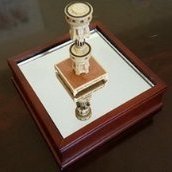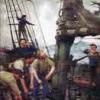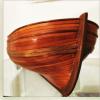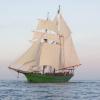
Matle
Members-
Posts
123 -
Joined
-
Last visited
-
 Dr PR reacted to a post in a topic:
Gjøa 1872 by Harvey Golden - Roald Amundsen's Cutter built at Rosedahl, Norway
Dr PR reacted to a post in a topic:
Gjøa 1872 by Harvey Golden - Roald Amundsen's Cutter built at Rosedahl, Norway
-
 druxey reacted to a post in a topic:
Gjøa 1872 by Harvey Golden - Roald Amundsen's Cutter built at Rosedahl, Norway
druxey reacted to a post in a topic:
Gjøa 1872 by Harvey Golden - Roald Amundsen's Cutter built at Rosedahl, Norway
-
 JKC27 reacted to a post in a topic:
F-Ships out of Finland
JKC27 reacted to a post in a topic:
F-Ships out of Finland
-
 Paul Le Wol reacted to a post in a topic:
F-Ships out of Finland
Paul Le Wol reacted to a post in a topic:
F-Ships out of Finland
-
Finnlines still exist, but were bought by Grimaldi almost 20 years ago. Probably they let Finnlines take care of Europe while other daughter companies focus on the Canada/US. They are quite active in the Baltic and launches new vessels from time to time. https://upload.wikimedia.org/wikipedia/commons/thumb/a/a7/Nordlink_Travemünde_(2008).JPG/960px-Nordlink_Travemünde_(2008).JPG
-
 dafi reacted to a post in a topic:
HMS Falken - little sister of HMS Wasa
dafi reacted to a post in a topic:
HMS Falken - little sister of HMS Wasa
-
 Mike Y reacted to a post in a topic:
HMS Falken - little sister of HMS Wasa
Mike Y reacted to a post in a topic:
HMS Falken - little sister of HMS Wasa
-
She wasn’t a sister ship of Vasa, ”little sister” is a media designation because it would have visually resembled a smaller Vasa. It was a 20-gun pinnace built 3 years after the Vasa, was in service as escort and transport for about twenty years. Haven’t seen any issues with design. It was built by the same builder - Hein Jakobsson - that took over the construction of the Vasa when the original shipwright fell fatally ill. Should be noted that Hein widened the Vasa as much as he could, so he probably didn’t like the dimensions he was handed over. Falken sank by grounding. By the way, ”HMS” wasn’t used by the Swedish navy at the time. The name Falken -Falcon- is still in service by the navy, and the current HMS Falken has incidently almost the same length overall as the 17th century pinnace:
-
 Matle reacted to a post in a topic:
Sutton Hoo Ship
Matle reacted to a post in a topic:
Sutton Hoo Ship
-
 Harvey Golden reacted to a post in a topic:
Gjøa 1872 by Harvey Golden - Roald Amundsen's Cutter built at Rosedahl, Norway
Harvey Golden reacted to a post in a topic:
Gjøa 1872 by Harvey Golden - Roald Amundsen's Cutter built at Rosedahl, Norway
-
 Paul Le Wol reacted to a post in a topic:
Gjøa 1872 by Harvey Golden - Roald Amundsen's Cutter built at Rosedahl, Norway
Paul Le Wol reacted to a post in a topic:
Gjøa 1872 by Harvey Golden - Roald Amundsen's Cutter built at Rosedahl, Norway
-
 Glen McGuire reacted to a post in a topic:
Gjøa 1872 by Harvey Golden - Roald Amundsen's Cutter built at Rosedahl, Norway
Glen McGuire reacted to a post in a topic:
Gjøa 1872 by Harvey Golden - Roald Amundsen's Cutter built at Rosedahl, Norway
-
 JacquesCousteau reacted to a post in a topic:
Gjøa 1872 by Harvey Golden - Roald Amundsen's Cutter built at Rosedahl, Norway
JacquesCousteau reacted to a post in a topic:
Gjøa 1872 by Harvey Golden - Roald Amundsen's Cutter built at Rosedahl, Norway
-
Hi Harvey, glad to stumble upon your build. I started building a model of the Gjøa years ago, and saw this by chance. Ørefiken had me stumbled for quite a while. I never figured out its purpose, but it appears to have been connected to one of the reef points on the staysail, pass through a block rigged on the shrouds and then belayed. I don´t remember exactly where the points were or even if it went port or starboard or both (and cannot check as I have my notes in another country... but I do believe one of the drawings showed the belay point), but in principle something like this: Yellow: ørefiken, blue: block, red: lashing for said block (nautical terms may have been translated badly) It was probably rigged somewhat differently on different yachts, and maybe differently on the same yacht depending on who was handling her. The word itself means a type of slap, the kind someone would de when boxing someone’s ear. It does refer to ”ear”, wonder if the word once meant ”ear pull” because that would make perfect sense? It’s a loanword from Dutch, who did supply plenty nautical terms too.
-
 Matle reacted to a post in a topic:
The Sinking of the Bismarck ... with LEGOs ...
Matle reacted to a post in a topic:
The Sinking of the Bismarck ... with LEGOs ...
-
Not sure if I can find something matching the Royal George in terms of artisanship, but the late 18th century Swedish navy is well represented by contemporary models, including a series of rather impressive 1/16 models - for these your macro lenses are probably overkill. 😃 Most of it is digitalized, see e.g. here (at the bottom of the page there are links to other sets of models): Ships: https://digitaltmuseum.se/021189676586/af-chapmans-linjeskepp Frigates: https://digitaltmuseum.se/021188835186/af-chapmans-fregatter Archipelago frigates: https://digitaltmuseum.se/021188555115/af-chapmans-skargardsfregatter Galleys: https://digitaltmuseum.se/021189712019/galarer
-
 Matle reacted to a post in a topic:
Collections of Ship Models: Help!
Matle reacted to a post in a topic:
Collections of Ship Models: Help!
-
Fregat and Snau: Small Cruisers in the Danish Navy 1650-1750
Matle replied to bruce d's topic in Nautical/Naval History
Thank you Bruce, it goes to my library. -
 Matle reacted to a post in a topic:
Papegojan 1627 by mati - FINISHED - 1/48
Matle reacted to a post in a topic:
Papegojan 1627 by mati - FINISHED - 1/48
-
"Royal Navy Warship" discovered near Riga in Latvia
Matle replied to Beef Wellington's topic in Nautical/Naval History
Although it was indeed not common due to less things eating the hulls, it did occur. Mostly though, wooden sheathing was employed, essentially an underwater sacrifical layer of thin planking. Even Swedish East Indiamen were sheathed in that manner. However, the major units of the Swedish navy were copper sheathed in the major overhaul around 1790, but none of those sank outside Riga as far as I know even though they did patrol the Baltic together with the British in 1809. If it’s indeed a large ship and indeed 200 years old (how did they conclude that, I saw no dendro?) the answer should be available in the archives. Probably in the Russian - they built their larger vessels with oak and copper sheathing too, at least a bit further into the 19th century. Wonder why they disregarded the most obvious answer? Otherwise, if ”oak” and ”copper” is all they’ve got, I can mention that plenty of later and lesser vessels were built of oak with copper sheathing - here’s one example: https://ru.m.wikipedia.org/wiki/Tre_Kronor_af_Stockholm edit: looking at the pictures with people in it, the size if the hull and planking makes me think this is a smaller vessel. -
Interesting article on wreck of "Gribshunden"
Matle replied to Ian_Grant's topic in Nautical/Naval History
I think we had a thread on this, but can’t find it now. Anyway, the archaeological reports are publically available. Here’s the latest: http://sh.diva-portal.org/smash/get/diva2:1519329/FULLTEXT02.pdf In Swedish, but with lots of pictures and an English summary at the end. -
Apologies if posted already - I do not visit often. Technology is taking leaps currently, and scanning and modelling (the computer kind) now enable the existance of armchair wreck divers. The Swedish digital wreck museum has uploaded a couple a while ago. I had somehow missed them and thought I’d share. The Anna Maria, a fluyt from the first decade of the 18th century: https://www.vrakmuseum.se/en/wrecks-and-remains/shipwrecks/anna-maria An unidentified wreck, probably another fluyt from the same time: https://www.vrakmuseum.se/en/wrecks-and-remains/shipwrecks/jutholmsvraket The 3D models are towards the bottom of the pages, and you can freely move around in them. The colouring and lighting appear to be designed to give the feeling of actually diving. Has anyone has seen any more?
-
 Matle reacted to a post in a topic:
Early use of cannon at sea
Matle reacted to a post in a topic:
Early use of cannon at sea
-
Thanks Dafi, those are quite convincing images I have to admit. Maybe the forces involved were not that great to threaten the integrity of the brackets/connections, and the inertia of the largest guns would perhaps take most/some of the forces. The rate of fire was as said not great. Even in the battles of the Northern 7-years war which were artillery duels, the ammunition consumption were surprisingly low. It’s still a silly thing to do, to balance outside the hull like that.
-
 Matle reacted to a post in a topic:
Early use of cannon at sea
Matle reacted to a post in a topic:
Early use of cannon at sea
-
Aye; it was applied in post #15
-
You are, of course, correct. When I said it wouldn’t move, I meant that any sideways movement would be insignificant, negligible - not that it would be absolutely 0.
-
Mark, I feel we might be talking past each other. The 16th century was a long period, full of experimentation and technological and tactical development. Even at the same time and place, different types of vessels were used with very different purpose and armament. For example, I focused my post on the pure-bred warship of the latter half of the 16th century in the Baltic - these were largely artillery ships. For the earlier type of breech-loaded heavy iron guns common during the end of the 15th and first half of the 16th centuries, having little recoil makes more sense.
-
I should really like to read it. Which time and space is he then refering to? None of the accounts of late 16th and early 17th century warfare indicates that the ships tried to disengage to load guns, rather the contrary. When Mary Rose sank, her newer guns had 4 wheel carriers while the older had only 2. Although this can be related to weight rather than age, adding wheels seems consistent with letting the gun recoil. One could argue that these were muzzle-loaded and wheels make hauling them back and forth easier, but it seems to me that someone would quickly realise that letting the guns do that job themselves seems like a rather tempting idea. And again, pinning the large guns would quickly damage them.
-
As you said, I can not address the article as I have no access, only the short points you posted. Since you did not address my main points, I feel you took the choice of word ”silly” a bit harsher than I intended: I did not mean to say that the author was silly to propose it, I merely meant that the idea of leaning out and trying to flip a 10-20 kg iron ball into a small hole, and powder too, seemed to me a rather impractical procedure to do, especially while simultaneously being shot at. I did not mean it in demeaning sort of way.
About us
Modelshipworld - Advancing Ship Modeling through Research
SSL Secured
Your security is important for us so this Website is SSL-Secured
NRG Mailing Address
Nautical Research Guild
237 South Lincoln Street
Westmont IL, 60559-1917
Model Ship World ® and the MSW logo are Registered Trademarks, and belong to the Nautical Research Guild (United States Patent and Trademark Office: No. 6,929,264 & No. 6,929,274, registered Dec. 20, 2022)
Helpful Links
About the NRG
If you enjoy building ship models that are historically accurate as well as beautiful, then The Nautical Research Guild (NRG) is just right for you.
The Guild is a non-profit educational organization whose mission is to “Advance Ship Modeling Through Research”. We provide support to our members in their efforts to raise the quality of their model ships.
The Nautical Research Guild has published our world-renowned quarterly magazine, The Nautical Research Journal, since 1955. The pages of the Journal are full of articles by accomplished ship modelers who show you how they create those exquisite details on their models, and by maritime historians who show you the correct details to build. The Journal is available in both print and digital editions. Go to the NRG web site (www.thenrg.org) to download a complimentary digital copy of the Journal. The NRG also publishes plan sets, books and compilations of back issues of the Journal and the former Ships in Scale and Model Ship Builder magazines.







